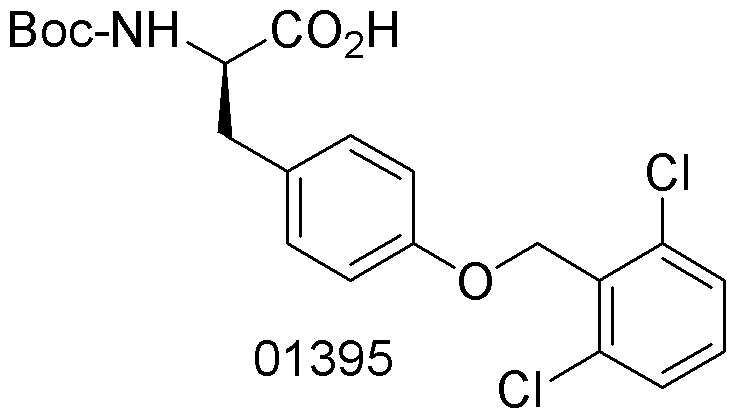Boc-O-2,6-dichlorobenzyl-D-tyrosine is widely utilized in research focused on:
- Peptide Synthesis: This compound serves as a valuable building block in the synthesis of peptides, particularly in the development of therapeutic agents. Its unique structure allows for the incorporation of specific functionalities that enhance biological activity.
- Drug Development: In pharmaceutical research, it is used to create novel drug candidates targeting various diseases. The compound's ability to modify receptor interactions makes it a key player in designing more effective medications.
- Bioconjugation: It is employed in bioconjugation processes, where it helps link biomolecules to therapeutic agents. This application is crucial in creating targeted therapies that improve treatment efficacy while minimizing side effects.
- Research in Cancer Treatment: The compound is explored in studies aimed at developing new cancer therapies. Its properties can be leveraged to enhance the selectivity and potency of anticancer drugs, addressing the challenge of drug resistance.
- Biochemical Assays: Boc-O-2,6-dichlorobenzyl-D-tyrosine is used in various biochemical assays to study enzyme activities and interactions. Its role in these assays provides insights into metabolic pathways and potential therapeutic targets.
Información general
Propiedades
Seguridad y normativas
Aplicaciones
Boc-O-2,6-dichlorobenzyl-D-tyrosine is widely utilized in research focused on:
- Peptide Synthesis: This compound serves as a valuable building block in the synthesis of peptides, particularly in the development of therapeutic agents. Its unique structure allows for the incorporation of specific functionalities that enhance biological activity.
- Drug Development: In pharmaceutical research, it is used to create novel drug candidates targeting various diseases. The compound's ability to modify receptor interactions makes it a key player in designing more effective medications.
- Bioconjugation: It is employed in bioconjugation processes, where it helps link biomolecules to therapeutic agents. This application is crucial in creating targeted therapies that improve treatment efficacy while minimizing side effects.
- Research in Cancer Treatment: The compound is explored in studies aimed at developing new cancer therapies. Its properties can be leveraged to enhance the selectivity and potency of anticancer drugs, addressing the challenge of drug resistance.
- Biochemical Assays: Boc-O-2,6-dichlorobenzyl-D-tyrosine is used in various biochemical assays to study enzyme activities and interactions. Its role in these assays provides insights into metabolic pathways and potential therapeutic targets.
Documentos
Hojas de datos de seguridad (HDS)
La SDS proporciona información de seguridad completa sobre la manipulación, el almacenamiento y la eliminación del producto.
Especificación del producto (PS)
La PS proporciona un desglose completo de las propiedades del producto, incluida la composición química, el estado físico, la pureza y los requisitos de almacenamiento. También detalla los rangos de calidad aceptables y las aplicaciones previstas del producto.
Certificados de análisis (COA)
Busque certificados de análisis (COA) ingresando el número de lote del producto. Los números de lote y de partida se pueden encontrar en la etiqueta de un producto después de las palabras "Lote" o "Lote".
Número de catálogo
Número de lote/lote
Certificados de origen (COO)
Este certificado de origen confirma el país en el que se fabricó el producto y también detalla los materiales y componentes utilizados en él y si se deriva de fuentes naturales, sintéticas u otras fuentes específicas. Este certificado puede ser necesario para cumplir con las normativas aduaneras, comerciales y regulatorias.
Número de catálogo
Número de lote/lote
Hojas de datos de seguridad (HDS)
La SDS proporciona información de seguridad completa sobre la manipulación, el almacenamiento y la eliminación del producto.
DownloadEspecificación del producto (PS)
La PS proporciona un desglose completo de las propiedades del producto, incluida la composición química, el estado físico, la pureza y los requisitos de almacenamiento. También detalla los rangos de calidad aceptables y las aplicaciones previstas del producto.
DownloadCertificados de análisis (COA)
Busque certificados de análisis (COA) ingresando el número de lote del producto. Los números de lote y de partida se pueden encontrar en la etiqueta de un producto después de las palabras "Lote" o "Lote".
Número de catálogo
Número de lote/lote
Certificados de origen (COO)
Este certificado de origen confirma el país en el que se fabricó el producto y también detalla los materiales y componentes utilizados en él y si se deriva de fuentes naturales, sintéticas u otras fuentes específicas. Este certificado puede ser necesario para cumplir con las normativas aduaneras, comerciales y regulatorias.


